1848 CAL. Quarter Eagle
 LeeG
Posts: 12,162 ✭
LeeG
Posts: 12,162 ✭
United States commemorative gold coins minted during the 19th and early 20th centuries form an elite series of just nine gold dollars, two quarter eagles, and two $50 gold coins. In addition, the 1848 CAL. quarter eagle is properly a part of the group but is often excluded.
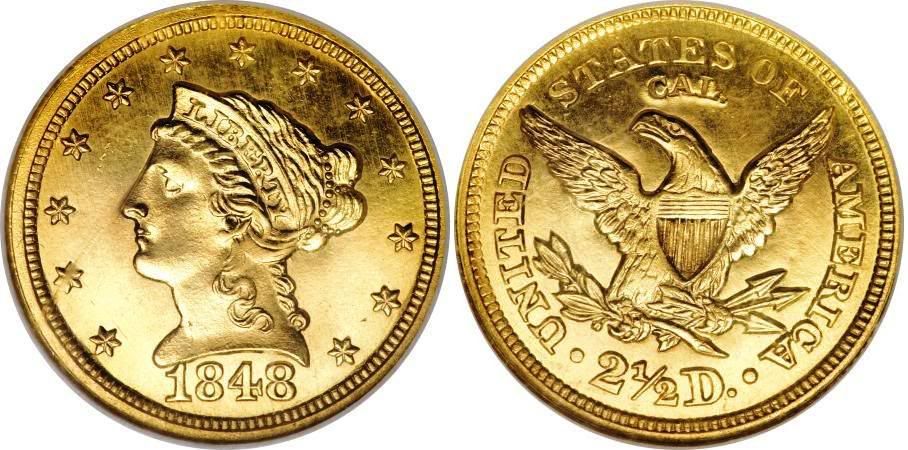
$2 1/2 CAL. MS68* NGC, sold for $345,000 on 01/12/08
On January 24, 1848, James Wilson Marshall noticed some small flakes of yellow metal near the Sutter's Mill project outside Coloma, California. Marshall's discovery turned out to be gold, touching off one of the largest voluntary migration of humans the world has ever known -- the California Gold Rush.
In December 1848, the Military Governor of California, Col. R.B. Mason, sent 228 ounces of newly mined gold to the Secretary of War, William L. Marcy. Marcy forwarded the gold to the Philadelphia Mint, with instructions to use the gold for Congressional Medals for Generals Zachary Taylor and Winfield Scott. Any leftover gold was to be turned into specially marked Quarter Eagles. 1,389 1848-dated Quarter Eagles were struck from the California gold shipment, each one stamped with a small "CAL." in the upper reverse field. The stamping appears to have been done while the coins were still in the press, as none of the obverse features appear to have been flattened. At least one example (the James F. Lindsay - 1978 GENA, Lot 1839 example) shows triple punching.
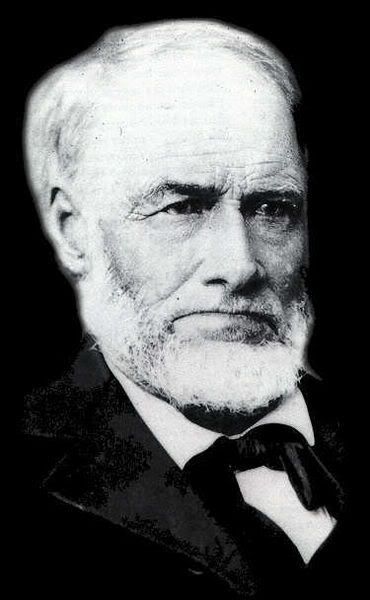
James W. Marshall, circa 1884
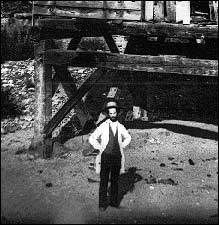
The discovery of gold at Sutter's Mill near Coloma, California, on January 28, 1848, ignited one of the most exciting times in our nation's history. People from all over the country, and the world for that matter, swarmed to the gold fields of California and surrounding areas. Considering the available modes of transportation at that time and the perils of traveling through uncharted territories, it is no wonder that many suffered hardships and even died during the long voyages to the Mother Lode region. But the allure of free gold, that beautiful, mystic metal highly prized by humans since prehistoric times, obviously outweighed the associated risks, and between 1848 and 1855 an estimated 300,000 people came in search of newfound riches. Settlements quickly sprung from the landscape, and many thrive to this day. San Francisco became a boom town, and infrastructure was promptly built throughout the region. Improved means of transportation, including advancements in railroads and steamships, fueled further development of California. All of these changes ultimately led to the admission of California into the Union as a state in 1850.
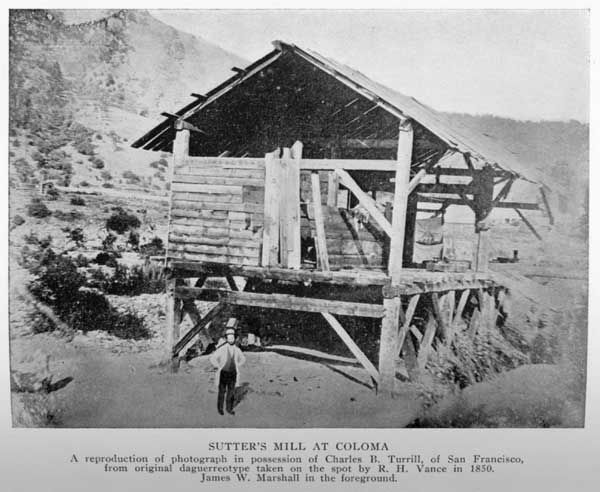
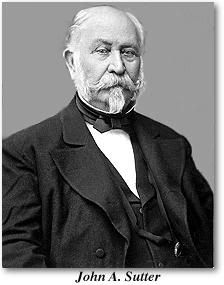
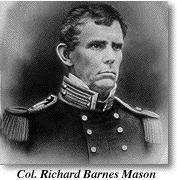
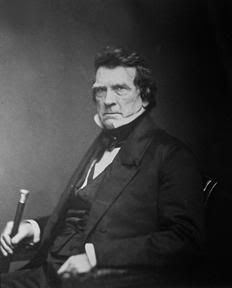
John Sutter, Col. Mason, William Learned Marcy
As important as the California Gold Rush is to the general public, it is particularly significant to coin collectors, as many classic numismatic treasures were born from this historic period. The first, and as such one of the most important, are the 1848 CAL. two and one half dollar pieces. The story of this coin is compelling. Although California gold had been used to strike Federal coinage at the Philadelphia Mint in the years prior to the Gold Rush, all gold deposits were treated as one source. Therefore today we have no way of identifying which coins were struck from California gold or other sources. That changed in August 1848 when a special shipment of gold was transported from the acting governor of California, Colonel R.B. Mason, to Secretary of War William Learned Marcy in Washington. Q. David Bowers remarks of this event in his landmark treatise on the subject, A California Gold Rush History: "We can trace the advent of coins specifically linked to California and easily identifiable as such to the purchase of 228 ounces of gold, averaging .894 fine, by Asst. Quartermaster Folsom in California who had obtained the metal for the bargain rate of $10 per ounce at a time when the metal was common and Spanish American and other coins in exchange were scarce. The money came from a civil fund." The gold was received by Marcy in December and subsequently shipped to the Philadelphia Mint. Marcy penned a letter regarding the precious metal to Mint Director Robert Maskell Patterson on December 8, 1848, as documented in the Bowers reference:
"If the metal is found to be pure gold, as I doubt not that it will be, I request you to reserve enough of it for two medals ordered by Congress and not yet completed, and the remainder, with the exception of one or two small bars, I wish to have coined and sent with the bars to this department. As many may wish to procure specimens made with California gold, by exchanging other coin for it, I would suggest that it be made into quarter eagles with a distinguishing mark on each, if any variations from the ordinary issues from the Mint would be proper and could be conveniently made ..."
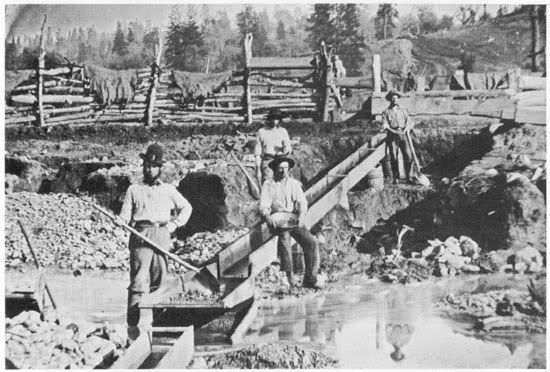
This is a photograph of gold miners in California, in the early 1850s, following the discovery of gold in that state in 1848. Much of the expertise that was employed in California came from miners who had previously worked the mines in the Southeastern U. S.
Breen surmised that the two medals mentioned by Marcy were for Generals Zachary Taylor and Winfield "Old Fuss and Feathers" Scott. However, a letter dated January 5, 1849 from Mint Director Patterson to Secretary of War Marcy states that "The California gold reserved for the medals is from another deposit ..." Apparently this letter was not available to Breen during the time of his research on the subject. The two gold medals were authorized by Congress to be presented to the two victorious generals and their ultimate contributions in winning the Mexican War. The Scott medal is permanently impounded in the Smithsonian Institution while the Taylor medal, a behemoth piece struck from 20 ounces of California gold, was sold as part of the November 2006 Norweb Collection by Stack's, where it realized $460,000. It is now accepted by researchers that the gold used to produce the two gold medals was actually derived from a deposit of 1,804 ounces of gold extracted from the American River near Sutter's Mill. This was the first arrival of California Gold Rush gold at the Mint, deposited by a prospector named David Carter on December 8, 1848, just one day before the 228-ounce shipment from Marcy arrived.
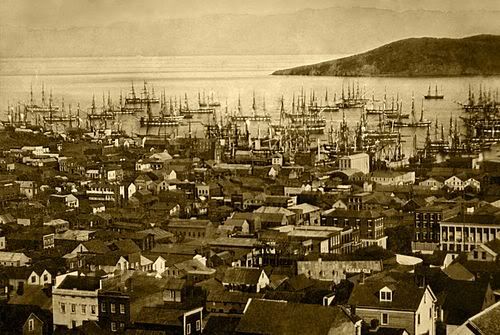
Merchant ships fill San Francisco harbor in 1850 or 1851.
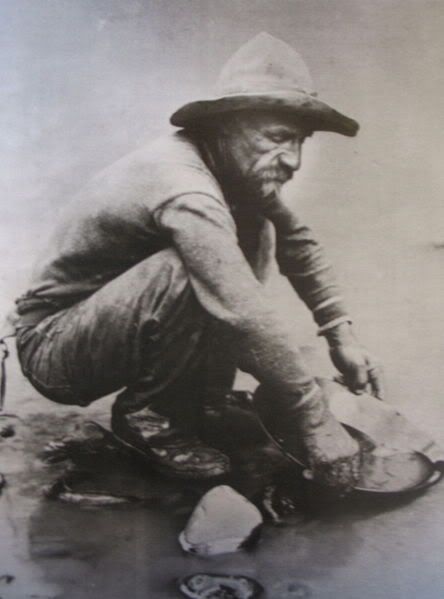
A forty-niner peers into his gold pan on the banks of the American river.
It is significant to note that the estimated 1,389 1848 CAL. quarter eagles struck were technically the first commemorative coins issued by a U.S. mint. Sufficient documentation exists to indicate that these pieces were intentionally modified to signify the earliest utilization of California gold in our nation's circulating coinage. The method of distinguishing the California pieces from the regular issue quarter eagles of 1848 was likely the work of Patterson, since Marcy did not provide specific instructions on this matter. Due to time constraints, the "distinguishing mark" first suggested by Marcy was a simple CAL. punch of one piece. It would have been interesting if a decision had been made to actually modify a working die for the California coins, but the urgency of producing the commemoratives dictated a simpler option. Since all known pieces are devoid of any obverse deformation, it is widely believed that each coin was manually stamped while in the die. When Marcy questioned the Mint Director on the delay of completing the project, Patterson provided the excuse that stamping each coin with the CAL. logo was "time-consuming."
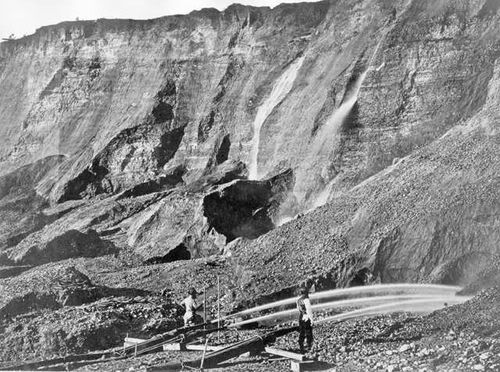
Gold miners excavate a gold-bearing bluff with jets of water at a placer mine in Dutch Flat, California sometime between 1857 and 1870.
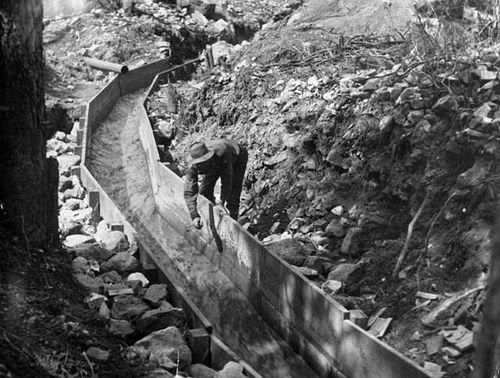
A man leans over a wooden sluice. Rocks line the outside of the wood boards that create the sluice.
Bowers notes that the 1848 CAL. quarter eagles "were available at face value to anyone desiring them. Although about 1,389 pieces were minted, probably fewer than two or three dozen numismatists--if indeed, even that many--learned of them at or near the time of issue and added the coins to their cabinets. Among those acquiring such pieces was Chief Engraver James B. Longacre, who preserved at least three prooflike specimens in his personal cabinet." Given the state of preservation and the semi-prooflike fields of the current example, one can easily accept the possibility that this piece once resided in Longacre's collection. Those coins not purchased at face value by the public obviously entered circulation, as evinced by the numerous pieces known in grades from VG through AU.
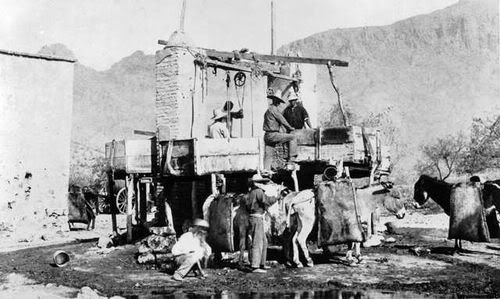
Miners operate a hydraulic sluice in San Francisquito Canyon, Los Angeles County. The placer mine machine consists of adobe columns, pulleys, ropes, and wood boxes. Donkeys are loaded with ore bags.

$2 1/2 CAL. MS68* NGC, sold for $345,000 on 01/12/08
On January 24, 1848, James Wilson Marshall noticed some small flakes of yellow metal near the Sutter's Mill project outside Coloma, California. Marshall's discovery turned out to be gold, touching off one of the largest voluntary migration of humans the world has ever known -- the California Gold Rush.
In December 1848, the Military Governor of California, Col. R.B. Mason, sent 228 ounces of newly mined gold to the Secretary of War, William L. Marcy. Marcy forwarded the gold to the Philadelphia Mint, with instructions to use the gold for Congressional Medals for Generals Zachary Taylor and Winfield Scott. Any leftover gold was to be turned into specially marked Quarter Eagles. 1,389 1848-dated Quarter Eagles were struck from the California gold shipment, each one stamped with a small "CAL." in the upper reverse field. The stamping appears to have been done while the coins were still in the press, as none of the obverse features appear to have been flattened. At least one example (the James F. Lindsay - 1978 GENA, Lot 1839 example) shows triple punching.

James W. Marshall, circa 1884

The discovery of gold at Sutter's Mill near Coloma, California, on January 28, 1848, ignited one of the most exciting times in our nation's history. People from all over the country, and the world for that matter, swarmed to the gold fields of California and surrounding areas. Considering the available modes of transportation at that time and the perils of traveling through uncharted territories, it is no wonder that many suffered hardships and even died during the long voyages to the Mother Lode region. But the allure of free gold, that beautiful, mystic metal highly prized by humans since prehistoric times, obviously outweighed the associated risks, and between 1848 and 1855 an estimated 300,000 people came in search of newfound riches. Settlements quickly sprung from the landscape, and many thrive to this day. San Francisco became a boom town, and infrastructure was promptly built throughout the region. Improved means of transportation, including advancements in railroads and steamships, fueled further development of California. All of these changes ultimately led to the admission of California into the Union as a state in 1850.




John Sutter, Col. Mason, William Learned Marcy
As important as the California Gold Rush is to the general public, it is particularly significant to coin collectors, as many classic numismatic treasures were born from this historic period. The first, and as such one of the most important, are the 1848 CAL. two and one half dollar pieces. The story of this coin is compelling. Although California gold had been used to strike Federal coinage at the Philadelphia Mint in the years prior to the Gold Rush, all gold deposits were treated as one source. Therefore today we have no way of identifying which coins were struck from California gold or other sources. That changed in August 1848 when a special shipment of gold was transported from the acting governor of California, Colonel R.B. Mason, to Secretary of War William Learned Marcy in Washington. Q. David Bowers remarks of this event in his landmark treatise on the subject, A California Gold Rush History: "We can trace the advent of coins specifically linked to California and easily identifiable as such to the purchase of 228 ounces of gold, averaging .894 fine, by Asst. Quartermaster Folsom in California who had obtained the metal for the bargain rate of $10 per ounce at a time when the metal was common and Spanish American and other coins in exchange were scarce. The money came from a civil fund." The gold was received by Marcy in December and subsequently shipped to the Philadelphia Mint. Marcy penned a letter regarding the precious metal to Mint Director Robert Maskell Patterson on December 8, 1848, as documented in the Bowers reference:
"If the metal is found to be pure gold, as I doubt not that it will be, I request you to reserve enough of it for two medals ordered by Congress and not yet completed, and the remainder, with the exception of one or two small bars, I wish to have coined and sent with the bars to this department. As many may wish to procure specimens made with California gold, by exchanging other coin for it, I would suggest that it be made into quarter eagles with a distinguishing mark on each, if any variations from the ordinary issues from the Mint would be proper and could be conveniently made ..."

This is a photograph of gold miners in California, in the early 1850s, following the discovery of gold in that state in 1848. Much of the expertise that was employed in California came from miners who had previously worked the mines in the Southeastern U. S.
Breen surmised that the two medals mentioned by Marcy were for Generals Zachary Taylor and Winfield "Old Fuss and Feathers" Scott. However, a letter dated January 5, 1849 from Mint Director Patterson to Secretary of War Marcy states that "The California gold reserved for the medals is from another deposit ..." Apparently this letter was not available to Breen during the time of his research on the subject. The two gold medals were authorized by Congress to be presented to the two victorious generals and their ultimate contributions in winning the Mexican War. The Scott medal is permanently impounded in the Smithsonian Institution while the Taylor medal, a behemoth piece struck from 20 ounces of California gold, was sold as part of the November 2006 Norweb Collection by Stack's, where it realized $460,000. It is now accepted by researchers that the gold used to produce the two gold medals was actually derived from a deposit of 1,804 ounces of gold extracted from the American River near Sutter's Mill. This was the first arrival of California Gold Rush gold at the Mint, deposited by a prospector named David Carter on December 8, 1848, just one day before the 228-ounce shipment from Marcy arrived.

Merchant ships fill San Francisco harbor in 1850 or 1851.

A forty-niner peers into his gold pan on the banks of the American river.
It is significant to note that the estimated 1,389 1848 CAL. quarter eagles struck were technically the first commemorative coins issued by a U.S. mint. Sufficient documentation exists to indicate that these pieces were intentionally modified to signify the earliest utilization of California gold in our nation's circulating coinage. The method of distinguishing the California pieces from the regular issue quarter eagles of 1848 was likely the work of Patterson, since Marcy did not provide specific instructions on this matter. Due to time constraints, the "distinguishing mark" first suggested by Marcy was a simple CAL. punch of one piece. It would have been interesting if a decision had been made to actually modify a working die for the California coins, but the urgency of producing the commemoratives dictated a simpler option. Since all known pieces are devoid of any obverse deformation, it is widely believed that each coin was manually stamped while in the die. When Marcy questioned the Mint Director on the delay of completing the project, Patterson provided the excuse that stamping each coin with the CAL. logo was "time-consuming."

Gold miners excavate a gold-bearing bluff with jets of water at a placer mine in Dutch Flat, California sometime between 1857 and 1870.

A man leans over a wooden sluice. Rocks line the outside of the wood boards that create the sluice.
Bowers notes that the 1848 CAL. quarter eagles "were available at face value to anyone desiring them. Although about 1,389 pieces were minted, probably fewer than two or three dozen numismatists--if indeed, even that many--learned of them at or near the time of issue and added the coins to their cabinets. Among those acquiring such pieces was Chief Engraver James B. Longacre, who preserved at least three prooflike specimens in his personal cabinet." Given the state of preservation and the semi-prooflike fields of the current example, one can easily accept the possibility that this piece once resided in Longacre's collection. Those coins not purchased at face value by the public obviously entered circulation, as evinced by the numerous pieces known in grades from VG through AU.

Miners operate a hydraulic sluice in San Francisquito Canyon, Los Angeles County. The placer mine machine consists of adobe columns, pulleys, ropes, and wood boxes. Donkeys are loaded with ore bags.
0
Comments
Thanks so much for sharing that information.
NB: Breen also had a habit of suppressing documents that did not support his published views.
Coin's for sale/trade.
Tom Pilitowski
US Rare Coin Investments
800-624-1870
Always wanted this coin but looks like that will never be, oh well.....
Well, just Love coins, period.
And the Spanish, who have a history of getting gold from the new world, never managed to look very closely at the Sierra foothills.
The evidence of small time Spanish mining from centuries past in the CA deserts are there. Primitive "arrastres" used to crush rock.
The stories of the American emigrants walking across the country is some pretty interesting reading. As far as coins go, they brought them along, mentioned only in passing in journals, and I suspect that of all of the things that were abandoned during the starvation marches, the light coinage was the 'last to go'. Well...next to the last to go anyway.
A beautiful coin, but once again, I see annoying plastic glare and scratches in front of it.
Thank You
TD
<< <i>The 1848 CAL is not a commemorative coin. At least not in the way numismatists speak of classic commemoratives. Classic commems were not made to circulate, are entirely different designs, and many times were minted to raise money for certain causes. >>
Some people focus on classic NCLT commems, however classic commems do not have to be limited to NCLT. We have modern commems with the bicentennials and classic commems with the CAL quarter eagles. The CAL quarter eagle was also not plagued by the abuses that eventually led to the end of the classic commem program. The intent to circulate the 1848 CAL makes it significant as the first commem and circulating commem.
<< <i>The 1848 CAL is a mint-made counterstamp and does not belong in the commem series. If you think the 1848 CAL is a commem then you must think 1873 "with arrows" coins are commems. It is the same principle. >>
I disagree. The CAL was issued to commemorate an event, the discovery of gold in California. The arrows were to indicate the changed amount of silver in the coin.
I started reading the story and I though, "that sounds familiar." Then I realized that I wrote that lot description for Heritage! I do like the way you bring the story to life with pictures and I wish we could do more of that when cataloging these types of coins.
<< <i>The 1848 CAL is not a commemorative coin. At least not in the way numismatists speak of classic commemoratives. Classic commems were not made to circulate, are entirely different designs, and many times were minted to raise money for certain causes. The 1848 CAL is a mint-made counterstamp and does not belong in the commem series. If you think the 1848 CAL is a commem then you must think 1873 "with arrows" coins are commems. It is the same principle. >>
Your certainly welcome to your opinion.
"From a technical and historical viewpoint the first United States commemorative gold coin was the 1848 quarter eagl produced at the Philadelphia Mint with the counterstamp "CAL". on the reverse to create a souvenir of the California Gold Rush."
<< <i>I started reading the story and I though, "that sounds familiar." Then I realized that I wrote that lot description for Heritage! I do like the way you bring the story to life with pictures and I wish we could do more of that when cataloging these types of coins. >>
You did a super job with it Dennis!
Added content.
Lifes all about learning!
I think if I could only own one US coin, that would be the one. I'll never own one, but it is a wonderfully historic coin - made with gold from the California gold rush sent all the way back to Philadelphia, counterstamped by hand while still in the die, and being both regular issue AND commem at the same time. There's no US coin remotely like it.
New collectors, please educate yourself before spending money on coins; there are people who believe that using numismatic knowledge to rip the naïve is what this hobby is all about.
In my opinion, the CAL $2.5 Libs should not be considered commems. They were not struck for the purpose to commemorate anything, and although they do mark the early stages of the California Gold Rush, arguably the most momentous event in United States history in the 19th century, the reason for their existence was strictly utilitarian---to identify the quality of California gold to be at par with the specie currently being coined at the Mint, and to assist in the substantiation of the claims that gold was present, in significant quantity, in California. There was a novel aspect to the countermark and the way they were distributed, but not enough so that they should be classified as commemorating the event.
<< <i>They were not struck for the purpose to commemorate anything, and although they do mark the early stages of the California Gold Rush, arguably the most momentous event in United States history in the 19th century, the reason for their existence was strictly utilitarian---to identify the quality of California gold to be at par with the specie currently being coined at the Mint >>
Thank you.
<< <i>The CAL was issued to commemorate an event, the discovery of gold in California. >>
QDB states this in his book, but I disagree with him.
Well, just Love coins, period.